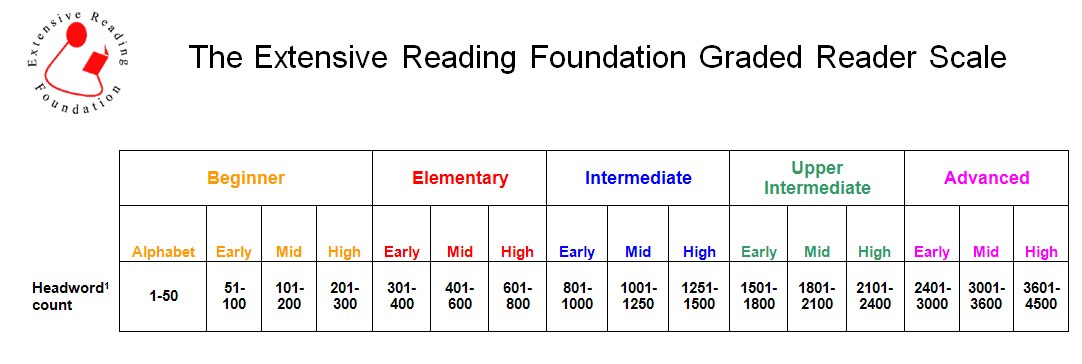What are “Graded Readers”?
Graded Readers are books of various genres that are specially created for learners of foreign languages. They may be simplified versions of existing works, original stories or books that are factual in nature. They are ‘graded’ in the sense that the syntax and lexis are controlled in order to make the content accessible to learners of the language. Publishers normally issue reader series with 4-6 different reading levels to suit a range of skill levels and allow progress over time. The Extensive Reading Foundation also refers to graded readers as Language Learner Literature (LLL), indicating that they comprise a valid, ‘authentic’ type of literature aimed at a specific readership. The ERF is currently involved in a number of graded reader initiatives, as seen below.
Graded Reader Awards
Through the Language Learner Literature Awards, the Extensive Reading Foundation has, since 2004, recognized the best graded readers of the previous year, with awards for each language level. See the “LLL Award Page” for further information.
The ERF is also pleased to have established a new award scheme named in honour of John Milne. As creator of the Heinemann Guided Readers series in the 1970s, Milne believed that the traditional grading of vocabulary and structure was not enough to make a book suitable for language learners. He therefore took a different approach, basing his series on good, clear writing, relevant content, careful explanation and control of information, and intuitive word and structure control. These innovations have been crucial in the development of language learner literature. See the “The Milne Innovation Award” for further information.
The ERF Graded Reader List
The Extensive Reading Foundation, in cooperation with publishers of EFL/ESL-targeted graded readers, has developed the ERF Graded Reader List, a comprehensive, searchable, downloadable database of current and out-of-print graded readers. The List actually consists of 3 types of sub-list: a set of publisher-specific lists, a “Combined List” gathering data from all publishers, and a “Various Readers” list with old reader series and non-ELT titles. Each list contains a wealth of information including author, level, word count, genre, ISBN, availability of MReader quizzes, etc. We hope this ongoing project will be a valuable resource for educators and learners and an effective way for publishers to present their readers and provide value-added service. Visit the gateway site to access the List and get helpful information on use and project participation.
For those in regions where the Google Doc is not accessible, here is a downloaded version in Excel, dated 11 Sept 2011.
Student Evaluations of Readers
The links below lead to three Excel spreadsheets that summarize data collected on MReader.org from the “post-quiz” questions that students respond to after taking a quiz on the book that they have just read. A total of more than 1,550,000 answers to “How did you like this book” form the basis of the data that is presented here.
- Most popular graded readers
- Most popular non-graded “youth” readers
- Evaluations of all readers by series
You are welcome to use the data for guidance in selecting books for your own library, but to assure that the data is properly interpreted, please consult with us before embarking on any publication that utilizes the data. <exec_at_erfoundation_dot_org>
The ERF Placement Test
The ERF has developed a placement test, which involves the reading of gradually more difficult passages, with the student report how difficult he/she felt each was before progressing onto the next passage. The result is a level on the ERF Graded Reader Scale (see below).
The ERF Graded Reader Scale
Publishers typically give the levels of a series names such as “Starter”, “Elementary” or “Intermediate” (or simply “Level 1”, “Level 2”, etc.), but unfortunately there is no standardization in how these terms are applied, and an “Elementary/Level 2” book from one publisher may be set at a very different language level than an “Elementary/Level 2” book from another. Fortunately, most publishers also provide headword1 counts for each level, and these provide a more accurate indicator. The ERF Graded Reader Scale uses headword counts to provide an approximate leveling scheme for Language Learner Literature, applicable across publishers and series. Note that since this is a rough leveling scheme, some individual titles may need to be moved up or down as indicated by personal judgement or reader response.
View a full introduction to the scale here.
1 A headword is similar to a dictionary entry where a group of words share the same basic meaning. E.g. helps, helping, helpful, helpless.

